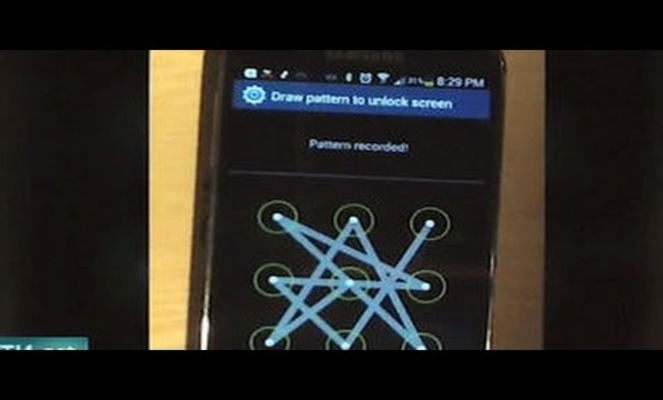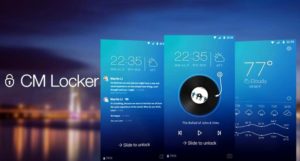Mobile devices penetrate deeper into our personal life every year. They store so much important and confidential information that its loss can threaten the owner with serious troubles. Special attention is paid to ensuring the security of mobile devices, and the first barrier in the way of attackers is blocking a smartphone Android.

- Security questions
- What is blocking used for
- Main types of blocking on Android
- Popular screen lock utilities
- Pattern lock screen
- Smart Phone Lock
- CM Locker
- How to set up a screen lock
- How to change the lock
- Blocking using the Google service
- How to block remotely Android
- How to enable geolocation
- Create an account
- Setting in the remote access panel in Google
- Additional Features Android Lost
- Getting root rights
- Preparing the program for use
- How to act if you lose your smartphone
- 6 types of screen lock in one app: Video
Security questions
One can talk for hours about the merits of one of the most popular operating systems, but the most controversial issue is ensuring its security. The well-known openness of the OS Android makes it possible to widely use its capabilities, but also provides ways for unauthorized access to the user's personal data. Each new version becomes less vulnerable, but the holes remain, and they are still used by dexterous dealers.
The freedom and irregularity of updates embedded in the operating system endangers the owner, and encryption of the user data partition is used only on devices with version 6.0 out of the box. There are many complaints about the abundance of authentication and unlocking methods using third-party applications. The increase in user capabilities leads to a proportionate increase in the risks of information leakage. And that's not counting the fact that Google constantly keeps gadget owners under the hood.
to the content
What is blocking used for
Few would think of sharing their innermost secrets on their own. And if most of them are in the smartphone, which is lost or stolen, then the first obstacle for prying eyes can be the screen lock.
Typically, unauthorized unlocking will erase all data from the device. Accounts, accounts, personal photos and much more will not get to outsiders. This cannot be called serious protection, but if there are small children or too inquisitive acquaintances in the house, they will not be able to accidentally remove them or accidentally transfer them into the wrong hands. It is a kind of simple interlock designed to protect against fast leakage.
to the content
Main types of blocking on Android
Blocking on the phone at Android with the release of each new version of the OS becomes more sophisticated. There are more ways that can be conditionally divided into two types:
- provided by the developer;
- provided by third party applications.
Both of them may differ in unblocking methods, the most common of which today are:
- finger movement;
- PIN-code;
- password;
- face or voice recognition;
- pattern key.
The user can get acquainted with the methods available for his device in the settings in the 'Security' section.

And which one to use, he will choose from personal considerations and preferences. For example, Swype is only good for protecting against accidental screen taps. Voice recognition does not work well in noisy environments, and faces are not yet a perfect way, they can be used by outwardly similar people. A graphic, regular password and PIN protect the entrance well and are used more often. If the available funds seem insufficient, you can always install a suitable program.
to the content
Popular screen lock utilities
Many programs have been created for such purposes, and their number is growing. A very large number are available for free on Google Play. There are many of them on the Internet. It makes no sense to talk about all of them, but some need to be highlighted.
to the content
Pattern lock screen
This utility is considered one of the best for display lock Android. Unlocking is possible by entering a pattern, PIN-code, swiping a finger or face recognition. Simplicity, fast and correct work make the program stand out from the crowd. Unlike others, the app allows you to change wallpapers and themes on the lock screen.

to the content
Smart Phone Lock
The application offers several original ways of blocking: with a time and date code with an offset (offset pin) or reverse input (reverse pin). In the first case, the user needs to enter a modified value for the actual time or date. In the second, enter them in reverse order.

to the content
CM Locker
This program locks the screen with a password, PIN or pattern. It seems to be nothing special, but if someone tries to open the phone several times, the device will immediately take a picture of it. The application has a built-in function that turns off energy-intensive processes, and you can use instant messengers and some other applications without unlocking.

to the content
How to set up a screen lock
Now let's move on to the most interesting for inexperienced users – where and how to enable screen lock on Android. This is done in the settings on all devices, without exception and regardless of the OS version. So, you need:
- Enter the settings and open the 'Security' section. On some gadget models, this may be the 'Location and Security' section, from which you need to go to the 'Change blocking method' subsection.
- Select 'Screen lock'.
- Determine the way.
- Make the necessary settings.

Regardless of the method you choose, it is important to properly set up the screen lock on Android. If it is a PIN-code, its parameters should exclude as much as possible the possibility of manual selection of a four-digit numerical value. It is easier to make a password unique, since in this case you can combine different characters – both alphabetic and numeric. When choosing a pattern, the line should be intricate, but you can't:
- connect start and end or use point twice;
- make a break between points;
- use less than four points.
You can use the secret word that you need to unlock. If you plan to use a fingerprint scanner, keep your fingertips dry and clean to create an accurate pattern. And if voice recognition is used, speech should be intelligible and calm. After that, you will need to specify the optimal time for automatic blocking and check the box 'Prevent clicks', which will eliminate accidental activation.
If there is a smart lock screen for Android – Smart Lock, you can select 'Trust Agents ' and activate the function. Then you need to specify the 'trusted' devices, locations and enable face recognition.

To lock on the face, you will have to perform several actions with the front camera. Lighting parameters and facial expressions should be standard.
to the content
How to change the lock
If you need to change the screen lock, this can always be done in the same settings section where it was installed. When choosing a new blocking method, you will have to confirm the old one by entering a password, PIN, etc. Further, a new lock is simply set, which we have already described.
to the content
Blocking using the Google service
Locking in case of loss or theft of a smartphone allows you to delete user data from it and make it temporarily impossible to control the device. If your smartphone is lost, you can find it using the Google service. When the device cannot be physically found, or new owners use it, you can always try to block Android through Google. Everything is done quickly and easily directly from the official website, but several conditions must be met.
to the content
How to block remotely Android
From version 5.0, locking is available with the integrated 'Remote Control' function. A device with an earlier version Android can be equipped with an application of the same name available on Google Play, and it will also get this opportunity.
Remote blocking is done through the Google online service, so the device must:
- have Internet access (mobile or Wi-Fi connection, it doesn't matter);
- be linked to a Google account;
- geodata transfer and search functions must be enabled.
to the content
How to enable geolocation
By allowing apps to use geodata, you can take advantage of mobile geolocation: get information about traffic jams, nearby restaurants, check in your favorite places, and the like. Anonymous data is sent to Google to help users determine their personal location, even when no apps are open. The Google service uses Wi-Fi hotspots and mobile networks for location.
To enable, you need:
- Enter 'Settings'.
- Open the 'Location' section.
- Select the 'Wireless networks' or 'GPS' mode. There may be other options – 'By all sources' and 'By grid coordinates'.
The function can be disabled at any time.
to the content
Create an account
To use remote services, including search and blocking, the mobile device must be associated with a Google account. To bind, you should:
- Enter the 'Accounts' section in the settings.
- If there is no Google search, add it. To do this, you need to create a mailbox on Gmail, the address of which will serve as a login to enter.
After binding, you need to open the 'Security' tab and select 'Remote control'. Then you need to continue in the Google settings on the PC:
- Select the 'Device Administrators' item.
- Check the boxes next to the corresponding items and activate remote control.
to the content
Setting in the remote access panel in Google
Direct control is performed from the site. For this you need:
- From the browser (on a PC or gadget), go to the link android.com.devicemanager.
- Log in with your account.

- Indicate your device (if you have several under one profile, select the required one).

- In the window that opens, click the 'Block' button.
- Enter the unlock password.
This service 'makes' the phone beep for five minutes, even if the speaker is muted.

In addition, from here you can create a message with a phone number or other information, which will be displayed on the screen of the lost phone.
to the content
Additional Features Android Lost
Even more possibilities are provided by the program created by Theis Borg. Utility Android Lost allows you to remotely do almost anything with the device. Let's just say that the list of features takes up a full page of standard text. You can download the program for free on Google Play.

Additional features include:
- deferral of blocking;
- tracking using a GPS tracker;
- sending SMS, including an alarm;
- sending SMS to the owner when changing the SIM card, including recording sound from the microphone and starting / stopping Wi-Fi via SMS;
- for version Android 2.3 – a photo of the intruder from the front camera;
- sending a list of incoming / outgoing calls to the owner by email;
- the ability to 'make' the phone speak aloud: 'I'm lost. Please take me away! ';
- erase the contents of the SD card with one button;
- playing a text message at full volume.
In addition, as the developer assures, the application has absolutely no effect on battery consumption, since it does not make requests to the server. But for it to work, you need to install the root.
to the content
Getting root rights
Granting administrator rights is a prerequisite for functioning Android Lost. You can get root on the device in different ways:
- With the help of software – special utilities installed on the gadget or a PC connected to it. There is no point in recommending something specific (there are no universal methods, and the optimal one for each gadget model is revealed empirically), but you can pay attention to Framaroot.
- Thanks to a flashing with the installed superuser rights.
The procedure is not always difficult, but it requires attention, since there is a possibility of disabling the device.
to the content
Preparing the program for use
To fully start using, you need:
- Download and install the program on the gadget. It is installed under a different name – Personal Notes, for disguise.
- Give her administrator rights.

- Register on the site.
You will have to use your Google account to register. The procedure is simple, straightforward and identical to that described above.
to the content
How to act if you lose your smartphone
If the phone is lost, proceed as follows:
- Login to the site Android Lost.

- Select the 'Controls' tab and immediately press the 'Lock phone' button. A block command is sent to Android and executed immediately.
Then you can control your device with almost no restrictions. All other actions depend on the owner's desire and his belief in the decency of the kidnappers or those who found him. They can be annoyed with endless calls, sirens and SMS, interference with the operation of system and software tools, and so on.
Finally, you can find your gadget yourself if it is enabled. The device will send the current coordinates with reference to Google Maps, even if the GPS module is turned off (using the cellular network). And theoretically it can be turned on.
to the content
